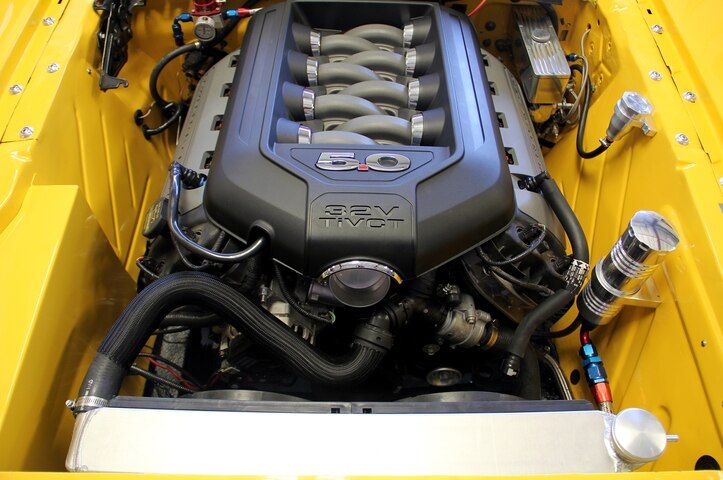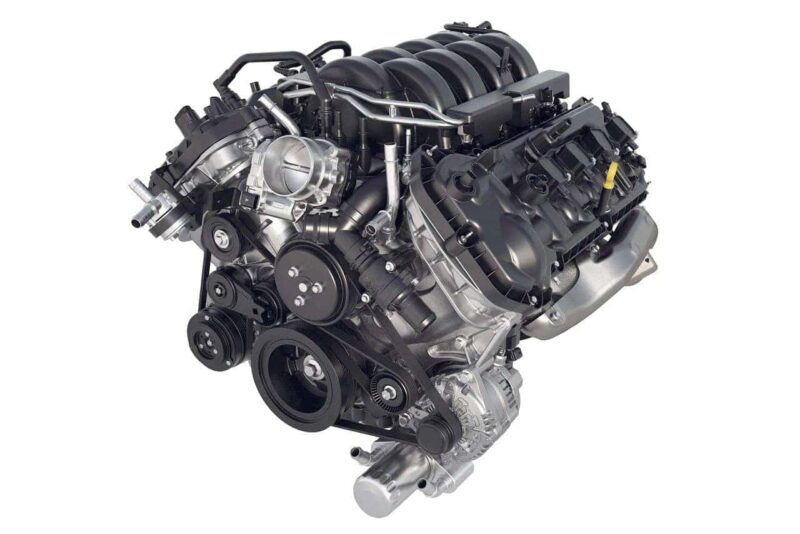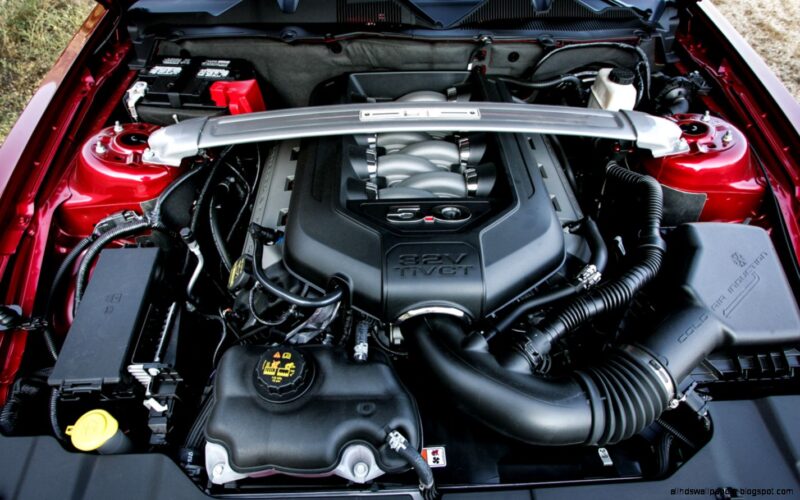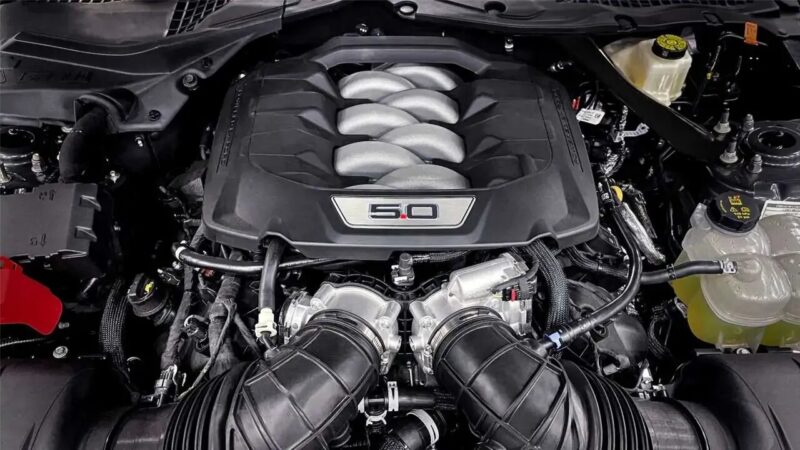The Ford 5.0 Coyote engine is a symbol of the modern era of American V8s. Introduced in 2011, it was Ford’s response to growing demands for power, environmental friendliness, and efficiency. This engine combines classic features with technological innovations: a naturally aspirated design, an aluminum block, four camshafts, and technologies from the world of motorsport. Today, the Coyote is popular among tuners, drift teams, and replica manufacturers, proving that the big naturally aspirated V8 is still relevant.
History and origins
Before the Coyote appeared, Ford’s arsenal was dominated by the 4.6- and 5.4-liter Modular engines. However, by the end of the 2000s, these engines were outdated on all fronts: they lacked power, the technology was lagging behind, and even the iconic Mustang GT was losing out to its competitors.
In 2010, Ford Performance engineers began developing a new naturally aspirated V8 with a focus on high revs, light weight, compactness, and compatibility with the Mustang and F-150. Thus, the Coyote was born — an engine named after the coyote, symbolizing strength, agility, and speed. Its mission: to become a worthy successor to the legendary 5.0 HO from the 80s and 90s and compete with GM’s LS series.
Key technical specifications
The Coyote is an all-aluminum V8 with a displacement of 5.0 liters. Unlike older Ford engine designs, it uses DOHC (four camshafts) and Ti-VCT, an independent variable valve timing system for both intake and exhaust. This not only provides good low-end torque but also high revs of up to 7,000–7,500 rpm.
Main parameters:
- Configuration: V8, 90° angle
- Displacement: 4951 cm³
- Block and cylinder head material: aluminum
- Camshafts: 4 (DOHC)
- Fuel system: distributed injection (in Gen 1 and 2), combined (Gen 3)
- Power: from 412 to 480+ hp depending on the generation
- Torque: up to 570 Nm
Coyote’s technology has made it powerful yet compact, making it an ideal candidate for both factory assembly and swap projects.
Engine evolution
Since its debut, the Coyote has undergone several major stages of development. Each new stage has brought improvements aimed at both performance and compliance with environmental standards.
Gen 1 (2011–2014)
The first versions were installed in the Mustang GT and F-150.

- Power: 412 hp (Mustang), 360–380 hp (F-150)
- Chain-driven camshafts, aluminum block with sleeves
- Plastic intake manifold
- Excellent response and high revs for a V8
Gen 2 (2015–2017)
This version featured lighter pistons, improved intake, and modified camshafts.
- Power increased to 435 hp.
- Higher compression ratio: 11:1
- New cylinder head with enlarged channels
- Improved cooling
Gen 3 (2018–2023)
The most technologically advanced version.
- Power: 460–480 hp (depending on Mustang model)
- For the first time, direct fuel injection combined with traditional injection
- Increased cylinder diameter, improved scavenging
- New crankshaft and connecting rod design
Gen 4 (2024+) (preliminary data)
- Increased service life
- Redesigned cylinder head and valves
- Potential compatibility with mild-hybrid systems
- Targeted to meet Euro 7 / EPA Tier III emissions standards
Performance and tuning
The Coyote quickly became a favorite among tuners thanks to its durability and potential. Even in stock form, it delivers impressive power, and with modifications, it easily reaches 600–700+ hp.
Potential:
- Superchargers (Roush, Whipple, VMP): up to 800+ hp on factory components
- Turbocharging: Twin-turbo builds — 1000 hp and above
- Bolt-ons: manifolds, intake, firmware — easy +30–70 hp gain
- Forged assemblies: for drag racing and maximum loads
Many Coyote-based assemblies participate in Time Attack, drag racing, and drag racing, and are also installed in classic muscle cars and Japanese bodies (for example, in the Nissan 240SX and Mazda RX-7).
Application
The main models in which Coyote is used:

- Ford Mustang GT (2011–2024) — the main “carrier”
- Ford F-150 — adapted for high torque
- Ford Falcon XR8 (Australia) — exclusive version
- Shelby GT350/GT500 — modifications such as Voodoo and Predator were created based on Coyote
- Swap projects — Coyote is popular among customizers due to its reliability and compactness
- Replicas of classic Fords — Cobra, GT40, etc.
Coyote vs. competitors
The Coyote is often compared to GM’s LS series and Chrysler’s HEMI, and each has its own strengths.
| Parameter | Ford Coyote | GM LS3 / LS7 | Chrysler HEMI |
|---|---|---|---|
| Configuration | DOHC | OHV | OHV + VVT |
| RPM | Up to 7500 | Up to 6500 | Up to 6200 |
| Tuning potential | High (supercharged) | Very high | Average |
| Ease of maintenance | Lower | High | Average |
| Price per hp | Higher | Lower | Average |
Conclusion: LS is simpler and cheaper in swap projects, but Coyote wins in stock in terms of speed and modern design. HEMI is a compromise between the two, but less common outside of Chrysler.
Problems and disadvantages of the Ford 5.0 Coyote
Valve noise (“Coyote tick”)
One of the most well-known features that causes concern among owners is a distinctive metallic ‘tick’ or “rattle” heard when the engine is warm. This is especially common in the Gen 3 (2018+) generation. Although Ford claims that this is a normal operating sound, its nature and persistence lead many to suspect a problem with the valve train or fuel injection system. In most cases, the noise does not cause any technical malfunctions, but it can reduce confidence in the engine.
Wear on phase shifters and timing chain drive
The Ti-VCT variable valve timing system provides excellent flexibility, but adds complexity and potential points of failure. Over time, the phase shifters themselves, solenoids, or timing chains may wear out, leading to misalignment, unstable operation, and errors. This is especially noticeable on vehicles with over 100,000 km on the odometer and irregular maintenance.
Increased oil consumption

Some Coyote engines, especially early generations, are prone to oil consumption in excess of normal levels. This may be due to design features, crankcase ventilation, or wear on the oil control rings. This is not always critical, but requires regular level checks and top-ups between services.
Sensitivity to fuel and tuning
The engine is sensitive to gasoline quality and control unit firmware. Using the wrong fuel, especially with a low octane rating, can cause detonation. It is also important to note that unprofessional calibration or tuning of the ECU often causes problems with ignition, mixture formation, and even overheating.
Overheating under high load
On the highway or during active use, the engine may suffer from overheating, especially without additional cooling modifications. Gen 1 and Gen 2 are equipped with a relatively weak standard cooling system that is not designed for continuous high loads. This makes it necessary to install oil coolers and more efficient radiators in tuning projects.
High maintenance and repair costs
Four camshafts, complex cylinder heads, and the presence of phase shifters make the Coyote expensive and difficult to repair. Its maintenance requires a skilled approach and specialized equipment, and the cost of labor significantly exceeds the cost of similar engines of simpler design, such as the GM LS with a single camshaft.
Difficulties when installing in other cars
Due to its size, the Coyote is not always easy to fit into classic bodies or swap projects. The DOHC heads make it wider and taller than its counterparts, requiring modifications to the engine compartment, hood, and sometimes the subframe. Although adaptation is possible, it requires more effort than installing engines with a compact architecture.
Recall campaigns
Despite its high technology and overall reliability, the Ford 5.0 Coyote engine has not escaped several official recall campaigns. Most of these were not related to design flaws, but to individual components affecting durability and safety.
2011–2012: Cooling system problems
Some Mustang GTs with first-generation engines had defective radiator hoses and thermostats, which in rare cases caused local overheating. As part of a service campaign, dealers replaced the cooling components free of charge.
2018–2019: Gen 3 — oil consumption and noise

With the launch of the third generation of engines, a problem arose with increased oil consumption and a characteristic “ticking” noise. Although this did not result in an official mass recall, Ford issued a series of TSBs (Technical Service Bulletins) with recommendations for diagnostics, replacement of PCV valves, and ECU reflashing. Owners were also offered an upgrade of the oil scraper rings when they contacted the service department.
2021–2022: Oil system hoses
Some F-150s with the 5.0 Coyote were recalled due to the risk of oil leaks caused by incorrectly installed oil hoses. The problem was fixed by replacing the fittings and seals at dealerships.
Awards and accolades
The Ford 5.0 Coyote engine has won recognition not only among car enthusiasts but also in the professional community.
Ward’s 10 Best Engines
In 2011, 2012, and 2018, the Coyote was included in Ward’s prestigious list of the 10 Best Engines, an authoritative ranking based on a balance of power, efficiency, innovation, and engineering. The engine received particularly high marks for its ability to reach 7,000+ rpm while remaining responsive in city driving.
SEMA Awards and recognition in the tuning community
At the SEMA show, the Coyote has repeatedly been chosen by customizers in the categories “Best Swap Engine” and “Most Promising Naturally Aspirated Engine for Tuning.” It was second only to the LS series in popularity, but beat it in terms of technology and modern design.
Recognition among Mustang owners
Among Mustang fans, the Coyote is often called “the best naturally aspirated engine in the history of the model.” It has earned a reputation as an engine that perfectly combines “old school” sound and torque with a new engineering philosophy.
Prospects and future
With the automotive industry’s transition to electrification, naturally aspirated V8s are under threat. However, Ford is keeping the Coyote in the Mustang and F-150 lineups for now, upgrading it to meet new standards.
- Gen 4 shows a trend toward improved environmental performance and lower emissions
- Hybridization or cylinder deactivation technology may be introduced
- The Coyote may remain the last “pure” naturally aspirated V8 in Ford’s mass production lineup.
- For now, it remains in demand not only at the factory, but also in the garages of enthusiasts around the world.
